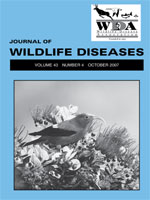We monitored Limestone Canyon hantavirus (LSCV) antibody prevalence, host (brush mouse, Peromyscus boylii) abundance, and environmental variables (temperature and rainfall) in brush mice captured on three trapping webs in southern Arizona for 5 yr. Although seasonal patterns were subtle, we observed large multiyear variation in population abundance and antibody prevalence. Limestone Canyon hantavirus infection in brush mouse populations varied over time with prevalence ranging from 0% to 33%. At all trapping webs, evidence of infection disappeared completely for an extended period (up to 2 yr) and eventually reappeared, suggesting that dispersal may play a role in maintaining infection in brush mouse metapopulations. Weather during the study period was drier and warmer than average and these conditions, especially during spring through fall, may have contributed to low brush mouse population density and the local extinction of LSCV during the second year of the study. Nevertheless, population growth was associated with relatively warm, dry conditions during winter periods and a cool, wet spring and summer period in the fifth year of the study. After prolonged absence, LSCV infection was consistently detected only when brush mouse population abundance reached relatively high levels during that fifth year. Comparison of our results to similar studies suggests that stochastic events resulting in the loss or survival of a few infected mice in low-density host populations may result in local extinction of virus; reestablishment of infection may occur via immigration of infected individuals from adjacent populations, but may be successful only when populations are of sufficient density to support frequent rodent-to-rodent interactions and virus transmission.
How to translate text using browser tools
1 October 2007
BRUSH MOUSE (PEROMYSCUS BOYLII ) POPULATION DYNAMICS AND HANTAVIRUS INFECTION DURING A WARM, DROUGHT PERIOD IN SOUTHERN ARIZONA
Amy J. Kuenzi,
Michael L. Morrison,
Nita K. Madhav,
James N. Mills

Journal of Wildlife Diseases
Vol. 43 • No. 4
October 2007
Vol. 43 • No. 4
October 2007
Brush Mouse
epizootiology
Hantavirus
Limestone Canyon virus
Peromyscus boylii
population dynamics




